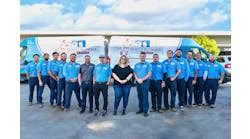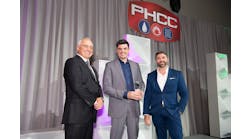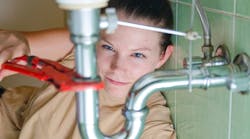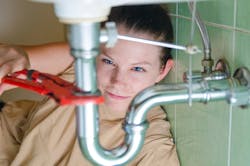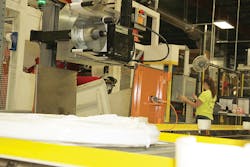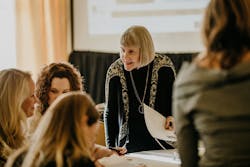CHICAGO — Just Google the topics “attracting women to trade careers” and “industries that lack women” and a multitude of articles and sources are available — article topics range from a lack of diversity and educational systems doing away with vocational electives to changing the stereotypical mindset of working in the trades and how to make the trades more attractive — and most of these articles bring up very valid points. But the question that remains to the trades — specifically plumbing and HVACR — is, “What steps can the industry take to move forward and entice women to have careers in the trades?”
This issue is a nationwide problem that plumbing and HVACR contractors are facing, but they are not alone — even some of the industry manufacturers are facing the same problem. According to the article “Manufacturing's Workforce Shortage Solution? Recruit Women” published by Penton’s own Industry Week, more than 4/5ths of manufacturers noted they cannot find all of the skilled workers they need, and part of this skills gap is due to a significant underrepresentation of women in manufacturing.
This led me to wonder what some industry manufacturers are doing to recruit women (and maybe contractors can glean some of the initiatives for their own businesses). For example, Uponor, a provider of plumbing, fire safety, radiant heating/cooling, hydronic piping and pre-insulated piping systems for residential and commercial applications, has been working closely on internal initiatives to recruit, retain and work with women in both manufacturing and office positions.
According to Erica Amevo, human resources manager of operations at Uponor, there are approximately 129 women working in Uponor North America.
“I was overseeing the hourly manufacturing staff, and in 2014 the company decided to focus on women in the workforce,” said Amevo. “We formed the Expanded Labor Pool (ELP) group at Uponor. This initiative has been around for about three years now. The task force looked at the manufacturing jobs to see what may be limiting women to apply to them, and we ended up changing some of the requirements, like how many pounds a person should be able to lift, etc.”
Another positive action the task force took was to put a couple of women on each shift.
“By having a couple of women working on each shift we are getting our factory employees to think differently — seeing women work these shifts may influence other employees to refer their girlfriends, sisters, nieces, and so on,” said Amevo. “People are now referring more women to apply to these manufacturing jobs. And in addition to this, women like to have role models at companies. We are trying to get women interested in pursuing different roles.”
Also in 2016 Uponor created a networking group for women employees.
“Women can make connections with one another now regardless of what area or department they work in,” said Amevo. “This way they can get a sense of what type of career paths are at Uponor. We are asking women in this group questions to find out what they are interested in, what they envision for themselves, etc. This feedback will help us put plans together, so we know what to specifically focus on to recruit and retain women employees.”
Uponor’s outreach to the community about recruiting employees is rather organic.
“There is the E3Stem Grant that is for anyone interested, yet we like to encourage females to apply for the grant,” said Amevo. “This is for students in high school and the first two years of a trade school. This is very helpful for students to be exposed to working in the manufacturing industry at a younger age. Once a student that has the E3Stem grant finishes high school, she can continue on in community college or a trade school.”
Uponor also offers company and manufacturing facility tours, plus Uponor has career panels that speak to the community, so the public is familiar with the company.
“We do many things to get the company name out there,” said Amevo. “We have also done some on-site job fairs in the past few years.”
The initiative Uponor has taken to attract women to careers at the company is ultimately based on educating the community.
According to Jesse Nergard, talent acquisition manager at Uponor, the company focuses on finding the best employees possible.
“Regarding targeting women, once there are a good number of women in the office, then we build that momentum via the women’s networking group,” said Nergard. “Overall we want the company to work for everyone. We have employee development programs, and our culture as a whole is very transparent. We are a friendly culture that uses teamwork and collaboration.”
A beneficial white paper
Renee Joseph, VP of channel sales and marketing operations at Johnson Controls Inc., spearheaded a white paper titled “Elevating the HVACR industry: Promoting exciting careers to diverse prospects can help address staffing shortages.”
The mechanical contracting world needs to figure out how to bring women into the industry, according to Joseph.
“There needs to be an awareness of what the industry really is,” said Joseph. “Many people don’t even know what HVAC means, so how do you create awareness of this? The challenge is how do you attract people to an industry that isn’t even well known, let alone attracting women to the industry?”
In Joseph’s white paper, industry leaders interviewed cite best practices for recruiting that likely would have substantial impacts if broadly replicated. These best practices are: raising the profile of technical college programs, supporting employers, supporting STEM education and getting students engaged.
“A seed has been planted with this white paper, and is a way to get at the heart of the problem,” said Joseph. “What are we going to do now? We need to figure out what we can do internally and what can we do externally. What challenges [internally] do we have in each area? Now we have teams that focus on theses pillars. What challenges we are seeing now? How do we select the things that will have the most impact? How do we put this in a business case and show a value to business? How do we interpret these things, and how do we formalize it into business cases? We are taking the good ideas and narrowing them down to a few, and then making sure we get the right people and resources to really drive this.”
“Renee is the genesis of this — a year ago Renee was meeting with key stake holders,” said Cheryl Kern, global director of Diversity and Inclusion for Johnson Controls, “seeing what we can do to be different to work on this issue of recruiting. We want to be very committed to this. In the long run we want best practices and processes the entire company should be utilizing.”
Earlier this year, Johnson Controls announced its Next Chapter program, which offers employment opportunities for women in science, technology, engineering and math (STEM) fields who are returning to the workforce after a two-or more-year break in their careers. Women selected for the Next Chapter program participate in an eight-week onboarding process customized to each individual.
In addition to serving as part of a project team, participants receive training to close any knowledge gaps, are exposed to networking opportunities and receive a dedicated coach/mentor. Successful candidates also have access to a support system led by the Women’s Resource Network, a business resource group that harnesses the power, influence and intelligence of Johnson Controls women employees to establish a community that fosters professional development and mentoring.
Women in HVACR
For Joseph’s white paper, Patti Ellingson, immediate past president of Women in HVACR was interviewed. And I had the opportunity to interview her for this article.
“There is no denying that a career in the trades is not typically a little girl’s dream,” said Ellingson. “This is not a career that is promoted within the education system as skills driven and exciting for either men or women. It is a career hidden behind the wall, in the closet, in the attic, on the roof — it is the unseen comfort of our daily lives.”
Ellingson also brought up the issue that society doesn’t recognize the importance of the mechanical trades in daily life, and it is something taken for granted until something breaks down, such as an air conditioner, toilet or water heater.
“As an industry we need to find a way to change the way even we look at this industry,” said Ellingson. “We have to educate the community about the vast opportunities within the trades, starting with getting the education community to recognize that a skill or a trade is as valuable as a 4-year degree and that these jobs are highly skilled and not (Blue Collar)… For those women who strive to work with their hands and problem solve, the HVACR trades is a great fit.”
Regarding men creating greater diversity in the trades, Ellingson doesn’t think it is necessary since there is a large deficit in a qualified workforce because of the aging labor force in the country.
“The only way to overcome this [deficit] is for more women to enter the HVACR field,” said Ellingson. “I do think that recruitment of women who are not afraid of male dominated careers, like those who are leaving the military, is a way to diversify the workforce. I have noticed that the mechanical contractors who are serious about hiring a women, also realize that there are significant differences in our strengths, and that there are some adaptations that are required, for example we do not have the upper body strength of a man, so lifting a ladder over our heads on and off a truck is very difficult and depending on our height impossible without a ladder. But there are drop-down ladder racks that allow for the ladder to be brought to an angle that allows women to remove and lift it without difficulty.”
Danielle Putnam, president of The New Flat Rate and Women in HVACR treasurer, looks at the issue of recruiting women from a historical perspective.
“In the presence of a shallow labor pool, America is not a stranger to women stepping up to the diving board,” said Putnam. “Decades ago when men were off at war, women went to work doing the jobs men had previously been doing. They may not have started out with the same skill sets, but no one is born with the exact skill set for a particular job. Performing for our jobs is a learned skill and women historically have been eager to learn the skills necessary to succeed so the 'jobs' get done. Nowadays, there are men doing an excellent job in our industry but there simply aren't enough of them joining the ranks to uphold future demand. To attract women into the men’s club, it needs to be a safe space. Work place respect should be strongly enforced. It's no longer about a he or a she, it's now becoming a 'we' and we all need to work together without gender discrimination.”
Recently Putnam was in a training classroom with 17 male contractors, the question was asked, “Why do you do what you do?”
“The overall answer to this question was, ‘I like helping people,’” said Putnam. “Our industry enjoys work that requires hands-on attention and the ability to find solutions and help people. It’s not all about first-world comfort. It’s about safety and relieving possible situations that could harm or negatively affect our customers, and that has an appeal to women.”
Ultimately recruiting women to the HVACR and plumbing fields comes down to both men and women currently in the industries coming together, working together, and creating internal and external recruiting initiatives. If you want to get involved, a good place to start is with associations, such as Women in HVACR.
“WHVACR is proud to have several paid male members in the organization, many of whom are also sponsors,” said Ellingson. “I do think that we could do a better job of reaching out to the men in our industry and making sure that they know we are not just an organization for women, but are an organization for recruitment and mentorship, education and networking. I have found over the past 12 years as part of this wonderful organization that even when we host a mixed event, the mindset can often be that this is an event for women only — and we have to say no, it is for all.”
